Caistor St Edmund – St. Edmund’s Church (Exterior)
It’s good to be back walking longer distances, and today’s ten-mile round trip was to Caistor St. Edmund. It’s a complex village because of its long history, so there might be quite a few posts and repeat visits for me to work it out to my own satisfaction. And probably to no-one else’s…..
I’ll have to come back so that I can find out more about this church, as due to the virus, they’ve closed off the whole churchyard. The church itself is of interest as it’s next to the remains of the Roman town of Venta Icenorum and there is Roman brick used in the repair and construction of the structure.
There was a church on this site from around the ninth century, which the Anglo-Saxons placed near to Venta Icenorum and on top of the Pye Road, which was the Roman road from the fort all the way to Colchester.
There’s a helpful information board by the entrance, which makes dating the different elements of the church much easier. The main part of the nave was built in the late eleventh century, with the chancel added in the thirteenth century. The porch and tower were added in the fourteenth century and the tower was crenellated in the sixteenth century. There was a thatched roof until 1800, when it was replaced and the roof-line was also lowered a little at this time.
The church is dedicated to Edmund the Martyr, the King of East Anglia between 855 and 869. What a wonderful honour being the King of East Anglia would be today, but I digress. He was killed when the Vikings attacked the country, but I prefer the Anglo-Saxon named for these invaders, which was the “Great Heathen Army”. He is buried at Bury St. Edmunds, which I still think is one of the most gloriously accurate of all place names in the area.






